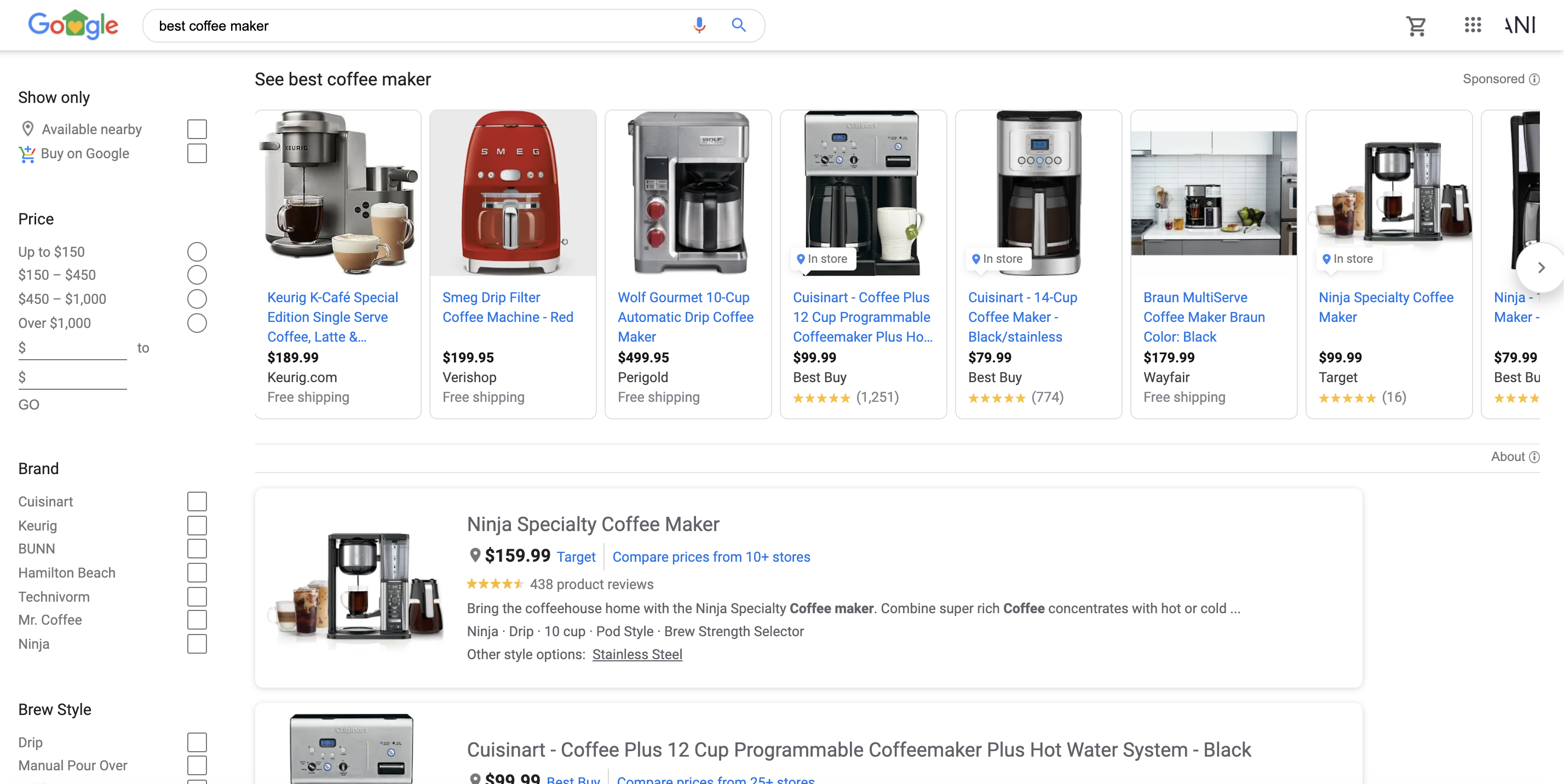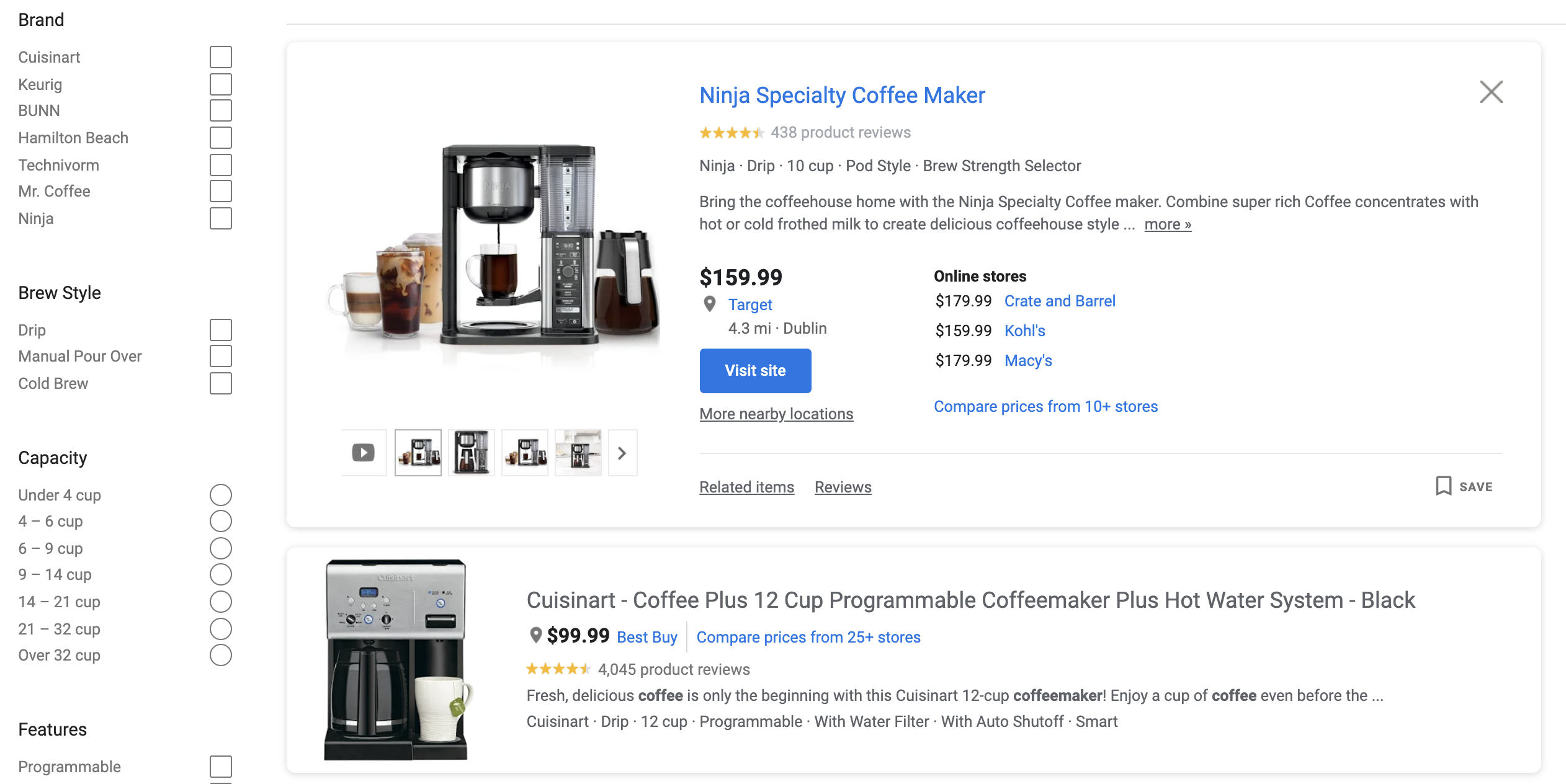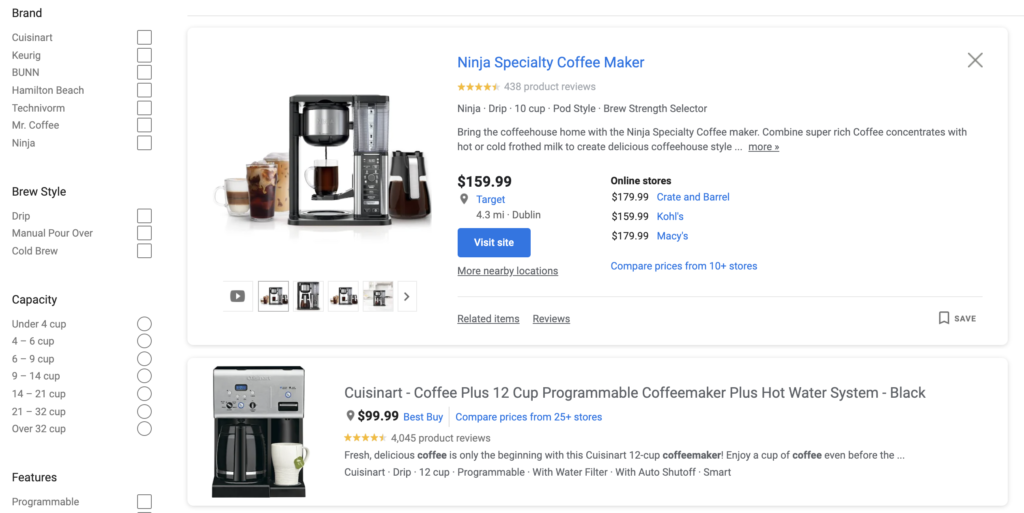The percentage of page real estate occupied by free listings in Google Shopping has gone from 0 to 48% in a little over one week (compared to 13% for paid listings, not including the horizontal scroll). The rationale, according to Bill Ready (Google’s president of commerce) is that “threats” are mounting in the retail sector and that, “digital commerce has become a lifeline for retailers.” Ready wants consumers and retailers to know that Google is on their side during the pandemic. Conveniently, the move is also a strategic hedge against Amazon’s online commerce takeover now that consumers do more product searches on Amazon than on Google[1].
So, who wins now that money can’t buy product love? We’ve analyzed some listings and the results are good news for businesses that understand the importance of brand authority and keyword relevance.

Who wins with free Google Shopping results?
There are a few folks that can, and will, see good things from this change. And plenty of companies can be part of that winning group if they play their cards right. (Especially those who are in countries not yet impacted by the update – get out ahead of it now!)
Online retailers with curated and structured product data
If…
- You’re using structured data on your product pages or you have set up your product feed: https://support.google.com/merchants/answer/7538732
- You have a Google Merchant Center account: https://www.google.com/retail/get-started/?product=merchant-center
- You have opted into “surfaces across Google” in your merchant center account: https://support.google.com/merchants/answer/9199328
- You’ve completed an audit to confirm that:
- Your structured data is valid
- All of your products are eligible to be shown
- You’re automatically updating product attributes (e.g. in-stock)
… then you’re off to a good start.
Brands can win
Brand authority has historically translated well into domain authority, which has pushed a lot of brands to the top of organic search rankings. This same authority also appears to be driving brand product listings to the top of the results, especially for brands that have been selling direct and collecting product reviews since before the shift to free listings.
Retailers that understand how keyword relevance works
The companies that have matched up their product names and descriptions with the phrases that potential customers are searching are seeing their listings rise and their sales jump.
That means you have to have a targeted keyword strategy – or what we call “Preferred Landing Pages” – where you’ve chosen a unique keyword for each piece of content and ensured that all of the product information are aligned to that specific item. Generic listings are going to cause issues for retailers, and a cleanup will be necessary to get back on top.
Who loses in the Google Shopping update?
Retailers that haven’t realized that “words matter”
If your customers are searching for “shirts” and “pants” but your listings say “tops” and “trousers,” you’re still not getting it. And Google’s going to punish your rankings for it. Search engines are trying to match searches with content. The retailers that realize this and put the time in to understand how users search for products are in a better spot to compete for listings real estate on the basis of algorithmic relevance than the companies that were manually targeting search terms and paying for exposure.
If you’ve got an e-commerce site with several country locations you need to make sure you’re presenting product pages that match those searches. If you have product titles that are confusing, misleading, or duplications – you’re going to have a tough time ranking. These are all true regardless of Google Shopping updates, but this is as good a reason as any to focus on the SEO and content marketing of your product pages if you were looking for one.
Companies that aren’t prepared to implement structured data
In order for products to be discovered and displayed in Google’s shopping feed, the data and images associated with the product have to be wrapped in markup that Google’s crawlers understand (example here: https://developers.google.com/search/docs/data-types/product#rdfa ).
This looks intimidating for non-technical folks, but if you have an ecommerce enabled site, your site framework is already structuring your product data. Adding these attributes (image, price, name, rating, …) just requires a couple of extra steps by your developers. Don’t forget that if you’re going to implement structured data, it should use the same curated keyword list and good research standards we mention above. Adding structured data that is a mess or improperly implemented won’t do you any favors!
Amazon Merchants (NOT brands themselves)
Yes, big brands are selling on Amazon, but thousands of Amazon sellers are obscure middlemen making a living off Alibaba and arbitrage without really knowing how to market anything or build a brand. Because they’re pushing goods as quickly as they can ship them out, they’re often not paying much attention to the quality of their site pages, a clear opportunity for those who craft well thought-out pages for their audience. If Amazon’s traffic drops, these guys will be the first to feel it, and most of them have no plan B.

Brand sellers, on the other hand, are reluctant participants in Amazon’s quest for one ring to rule them all. Amazon disconnects them from their customers, cheapens their brand, and drives their profit margins down. As soon as there is a clear place to land, they will jump.
What are your next moves for a solid Google Shopping strategy?
- Audit structured product data and make sure everything is buttoned up. This is the starting point of it all – no structured data means no shopping listings. If you want to understand site audits a bit better, there’s a good series here:
Site audit strategy 101
What should I expect from site audit deliverables?
Site audits: Determining who should do them and when - Check your product feed. If your product listings aren’t selling as much in Google now as your paid listings were previously, and you’ve confirmed that your feed is set up correctly, you probably need to reevaluate your product titles and descriptions and make sure they match the phrases your potential customers are searching
- Build authority. If you’ve been jumped by a bunch of brands selling direct, you’re losing the authority battle. If you had asked Matt Cutts (when he still did this type of thing) he would tell you that there are no shortcuts to becoming an authoritative, relevant source in the eyes of Google. You need a content and user engagement strategy. Or more concisely, be interesting.
The shift to free listings is a fantastic opportunity for companies that have put the time into making their product listings findable, especially because it allows them connect directly with their customers, as opposed to selling through Amazon (who won’t even allow them to know which cities their customers live in). Not only is this a chance to get a meaningful boost in the bottom line, it’s also an opportunity to do a better job of measuring direct interactions that lead to purchases. If you’ve found yourself on the outside looking in at these new results, you can still bounce back fairly quickly if you get your listings cleaned up. Let us know if we can help.
[1] https://www.retaildive.com/news/amazon-now-dominates-google-in-product-search/531822/

